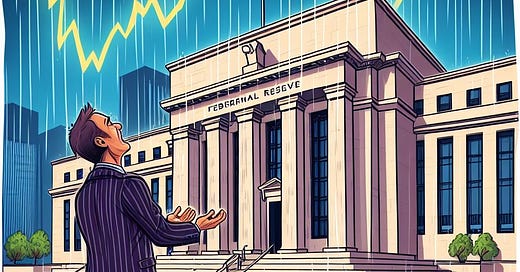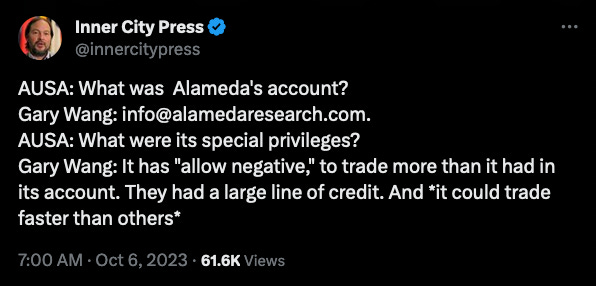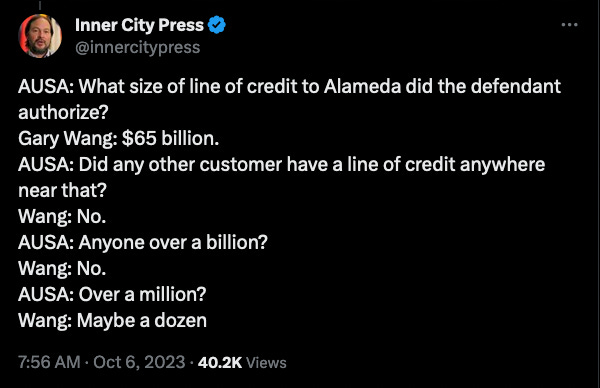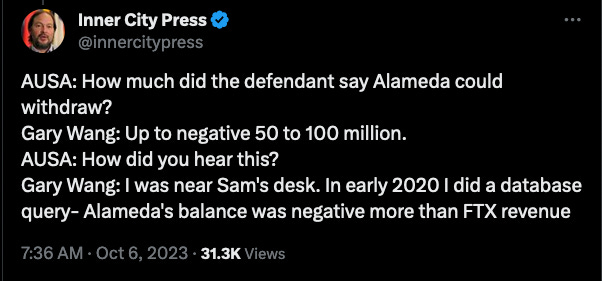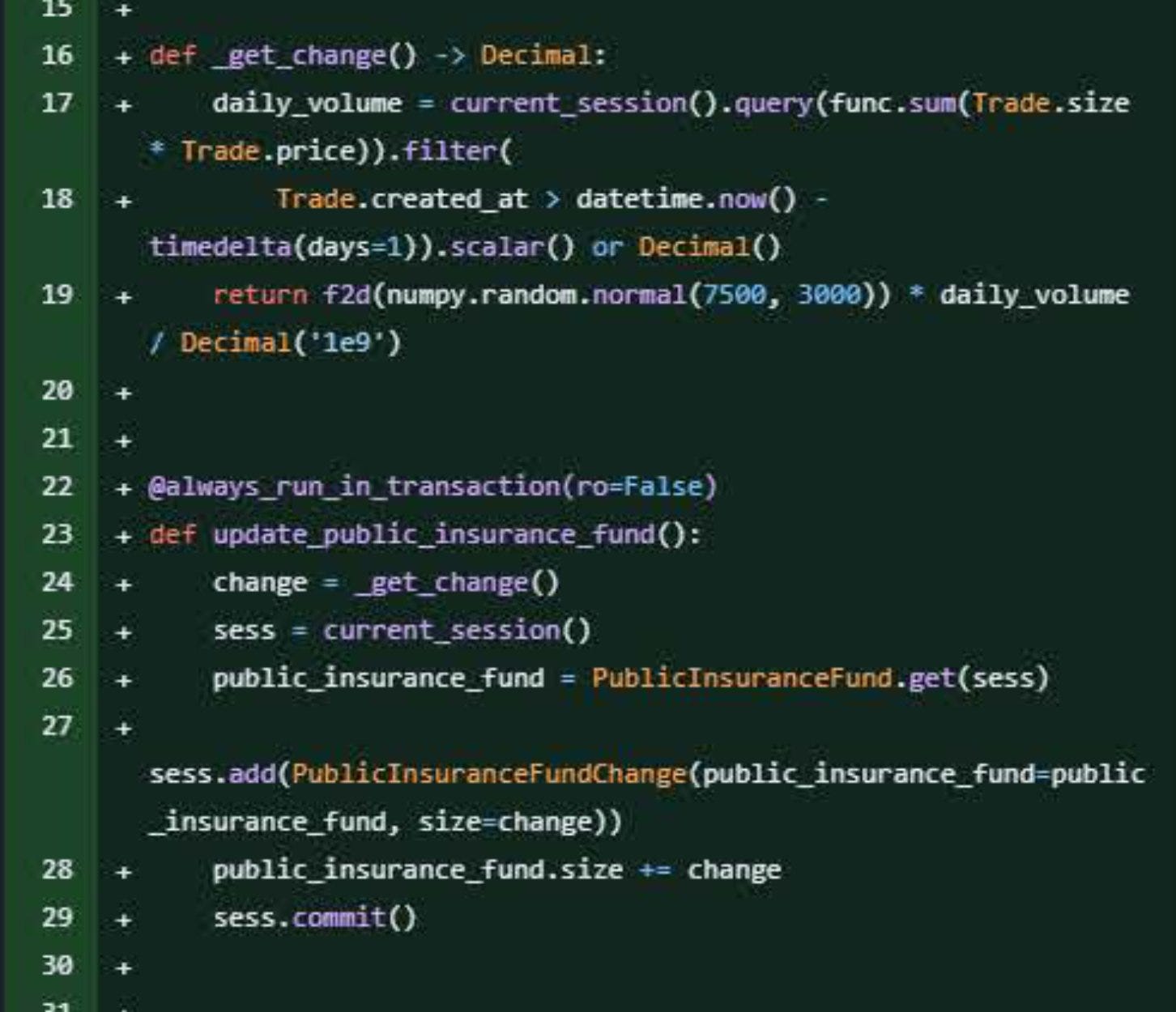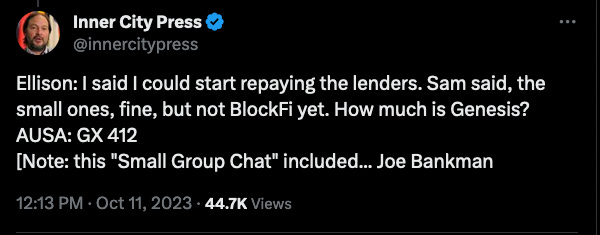The Shit has hit the fan — Warren Zevon
It has been a while since I’ve actually written about FTX, largely because after the initial hullabaloo of figuring out 1) what happened, harping on it seemed moot until the trickle of legal filings started coming out (which you can see my commentary of on X.) But now that Sam Bankman-Fried is finally on trial, perhaps it’ll be good to take a quick refresher on what exactly went on here. (And for real-time coverage, here’s Inner City Press on X)
Up until recently [Nov 2022 ~ ed.], I think it’s safe to say that the general assumption about Alameda Research was that they were good at trading (or at the very least, competent.) There have been rumblings about front-running and their relationship with FTX for a long time, of course, but there was nothing really concrete, and, if they were front-running, it would at least indicate some type of edge (as that isn’t technically illegal in the Wild Decentralized West.) In the last week, we’ve talked about the actual liquidity crunch and some potential fallout of what happened. Over the weekend, though, some details came out about FTX’s balance sheet itself - and personally, I think the story shifted heavily from “misusing leverage and getting caught out while trading” to “outright fraud.”
Some other pleasant links to read are the “What Happened at Alameda Research” post and this Nansen analysis of all the wallet transactions associated with FTX and Alameda.
There are plenty of places to read about the drama surrounding FTX and to bash Michael Lewis and other mainstream media for writing endless fluffpieces about a prolific, pathological liar who, as Chappelle would say, clearly did that shit. Rather than litigating out the case myself, which serves no purpose, I’ll add some commentary to stuff I’ve generally observed myself, heard over the years, think about criminal trials, and more. I’ll be relying on rough transcripts from Inner City Press primarily (because I looked up the cost of official ones and, holy shit, they are not cheap), who happens to post a lot of threads of court hearings in a tremendously beneficial service as a reporter, and other court documents as I happen to need them. (Note: I’m going to screenshot a lot from his live feeds. Please give him a follow!)
Though the actual mechanisms and transaction volumes might seem confusing, in essence (ignoring the campaign finance charges, which are derivative), this case is very straightforward. If you are a bank/certified broker, you have some ability to maneuver customer deposits through your business. If you are an exchange, you cannot. And if you are an exchange, your biggest liquidity provider being a hedge fund you own is a severe conflict of interest. Without very strict compliance and accounting in place, bad actors can do what they want. And when you give a bunch of junior traders billions of dollars and they start losing money, they’re more likely to plug the hole than admit they fucked up. Recall what I wrote a while ago:
I generally think there are two major motivations for committing financial fraud. One is greed/hubris - “I know better than other people what to do with money, therefore I deserve it more.” The second is borne out of befuddlement - “I’m a smart person, and can’t believe I’m losing money! If I just had more to work with, I can make it back and then some.” Publicly, given the weird effective altruism cult mentality espoused by SBF, it’s easy to say it’s type one, and people who personally know him could probably attest to that if true. But as a trader, I’ve seen type two happen time and time again when objectively smart people become unable to turn a profit.
I started writing this before the trial really got under way, but I figured I’d wait until I got some confirmation of my intuition as Gary Wang and Caroline Ellison were going to be called to the stand. And boy, I wasn’t disappointed. Here goes.
Something I was curious about as the trial started was how the prosecutors would avoid getting bogged down in the weeds. Traders and developers are not known for being, well, particularly socially adept and able to explain things in a very simple manner (and, of course, some things simply can’t be dumbed down.) Crypto transactions are not particularly intuitive, and the language of “wallets” or the difference between “on-chain and off-chain” could be particularly vexing for a jury. Nevertheless, what I wanted to hear from Gary Wang was two things in particular: one, did Alameda have a backdoor/speed advantage on FTX’s platform, and two, that Alameda was exempt from normal margining limits. Gary confirmed both:
Gary went on to say that SBF instructed him to do this and confirmed (as anyone should know) that none of this is necessary for “market making” (and, in fact, in any strictly regulated jurisdiction, the uneven playing field is explicitly illegal.) But what’s interesting is that he testified that Alameda was already in the red in 2020 itself.
The leaky trading strategy and the backdoor that nobody really looked for (but everyone with trading knowledge suspected existed) led to the creation of FTT, a token that was supposed to act like equity in FTX (but, of course, could not directly be equity in FTX for legal reasons.) Recall what I described the function of FTT as back in November 2022:
FTX would stabilize the price of FTT by purchasing and burning the supply. In addition, FTT was stake-able for interest income, and, of course, tradable with leverage…
The more FTT held, the more perks one would get for trading on FTX, including “lower fees” and “VIP access” based on tier. For the exchange, token issuer, and floor-maintainer to be so financially tied to a primary market maker/trader and its collateral is nefarious self-dealing - it practically incentivizes front-running from the trading arm (or, as some would put it, “using traders as exit liquidity.”) One can put together a simple model for raising trading capital for Alameda: FTX takes in funds through trading fees and by issuing FTT and incentivizing its purchase. Alameda takes in FTT through issuance for market making on the platform and by purchasing it privately or publicly and marks it on their book at some % of whatever FTX is maintaining the price at, discounting for volatility, and then proceeds to borrow against it. Whatever profits Alameda makes trading is further plunged into the FTT/loan fundraising scheme, creating a sort of feedback loop for increasing leverage and trading capital, fully supported by FTX’s usage of trading fees to maintain FTT price.
Wang’s testimony was so damning (and the cross was so impotent) that I began to wonder why this case even made it to trial, unless SBF wasn’t even offered a deal at all in the first place, which would make sense. You don’t get co-conspirators to plead guilty unless you’re going for the head of the operation. Of particular note was this egregious “backstop fund” for depositors that FTX promoted was just a randomly generated number that did not represent the reality that FTX in fact did not have any money to cover investors:
Reading Wang’s testimony, I began to feel a little bad. Here’s a guy whose deskmate did not hear Wang speak more than 6 words directed at him over the course of 6 months (according to Michael Lewis)
claiming, very convincingly, that he pretty much just did what he was asked to. And by all means, the actual FTX product even with the speed bump was a really fluid, fantastic trading experience. None of the drawbacks — predatory liquidation, leverage, and products offered — were unique to FTX in the space, and objectively their core exchange was pretty great stolen money notwithstanding. And if this org chart is accurate, Wang, as a CTO with zero direct reports (lol) seems to have absolutely crushed it building the legitimate side of the product.
Inevitably, he is likely to be banned from the securities industry, made to serve some sort of arrest-type punishment (the sheer scale of the money involved would necessitate that imo), and forced to return whatever illicit money he received, but man would this kind of productivity be wasted building some adtech or SaaS bullshit. As a friend suggested, have him fix TreasuryDirect.
Of course, the main witness that everyone was waiting for was Caroline Ellison, SBF’s ex-girlfriend and CEO of Alameda when everything came crashing down. Her statements had to show two things: one, that SBF directed the use of customer funds to plug the holes at Alameda, and two, that she did not sabotage the operation due to the failed romance with SBF, as one of his defense claims is that she acted out as a jilted lover.
To start, her testimony made me uncomfortable. I don’t know if anyone reading this follows golf, but do y’all remember Tiger Woods’s press conference talking about his transgressions being broadcast live on every channel around the world? For a trial as closely followed as this one is, it seems incredibly unseemly to have to explain your intimate life and your failed relationship on the stand. I felt a sense of pity reading through these personal comments as she recounted how SBF refused to acknowledge that they were dating or acknowledging any sort of emotional attachment whatsoever (which, again, was necessary due to the planned defense.) For fuck’s sake, she was writing memos to him about these topics! Look, everyone is aware of their attractiveness, but men pretty much just have to exercise, dress well, and keep their head up high to look decent, whereas for women it is not so easy. And all things considered, she maxed out the other side of things by doing a Stanford math degree and making it into Jane Street, which requires a pretty high aptitude even if you’re not particularly competent at trading. After doing all this, she quit her cushy job to find out that the “promising trading operation” she was pitched on being a part of was actually this fly-by-night haywire mess with no accounting or trading logs at all. And then when she testifies and is forced to tell every detail of the story (which increasingly looks like her just having fallen for a total psychopath), everyone makes fun of her for being ugly. Even my cold, cold heart feels a flicker of empathy as I imagine myself in the same situation.
Her testimony, though, was incredibly damning as well, perhaps even moreso than Wang’s. Virtually everything that was suspected came out — that SBF was directing Alameda even after he “gave up” control, that he directed FTX customer money to be used to cover Alameda’s loans and losses, and that he made consistent false statements about FTX and Alameda’s financial stability. Hilariously, the balance sheet referred to above was fudged to look significantly better, and the massaged numbers blew up FTX (and, ironically, DCG, the parent company of Coindesk, the site that broke the original balance sheet story.) Barring some incredibly impeaching cross examination, it seems that SBF’s chances at winning are far, far OTM at this point. I’ll have a follow up post on actual trading commentary on what I’ve seen from the trial so far (and addressing the whole Anthropic/Sullivan and Cromwell situations), but it’s nice to see a lot of my intuitions from pre-blowup confirmed.
Initially, I expected to see evidence of a bunch of clowns blowing a bunch of money that they had no rights to. Now, I see a hypercompetent coder who didn’t know how to confront the boss and pull the plug and a junior trader in waaaaay over her head, all being manipulated by a psychopath (and his scummy family.)
Frankly, I’m not sure what to make of this all at the moment, other than being thankful that the person on trial is the right one to face all these charges. The sheer scale of gullible idiots involved here, from renowned VCs to best-selling storytellers, is astonishing.
Once again, it points to the fact that interest rates are inversely correlated with fraud. When it goes low, fraud goes high. To be continued…


